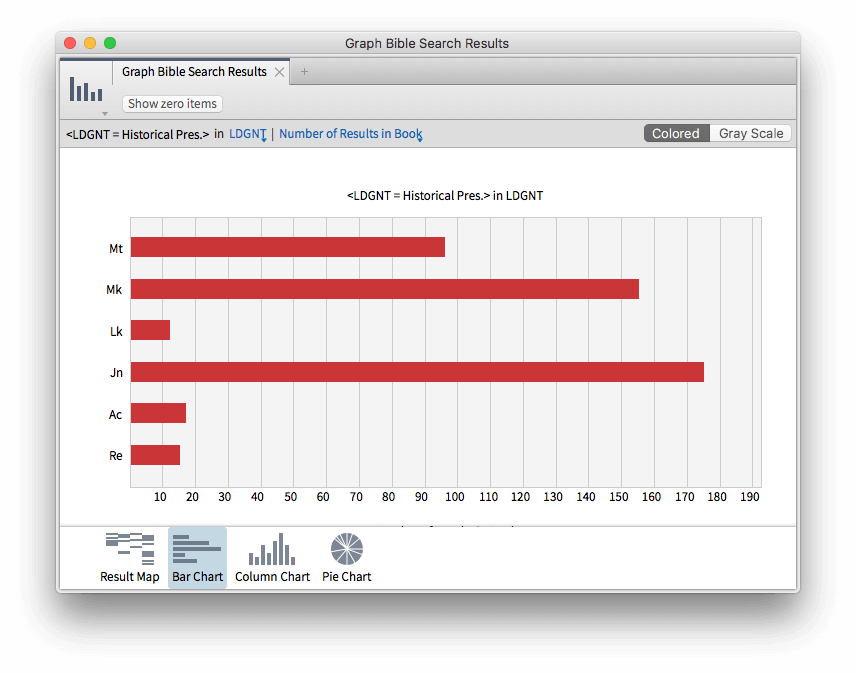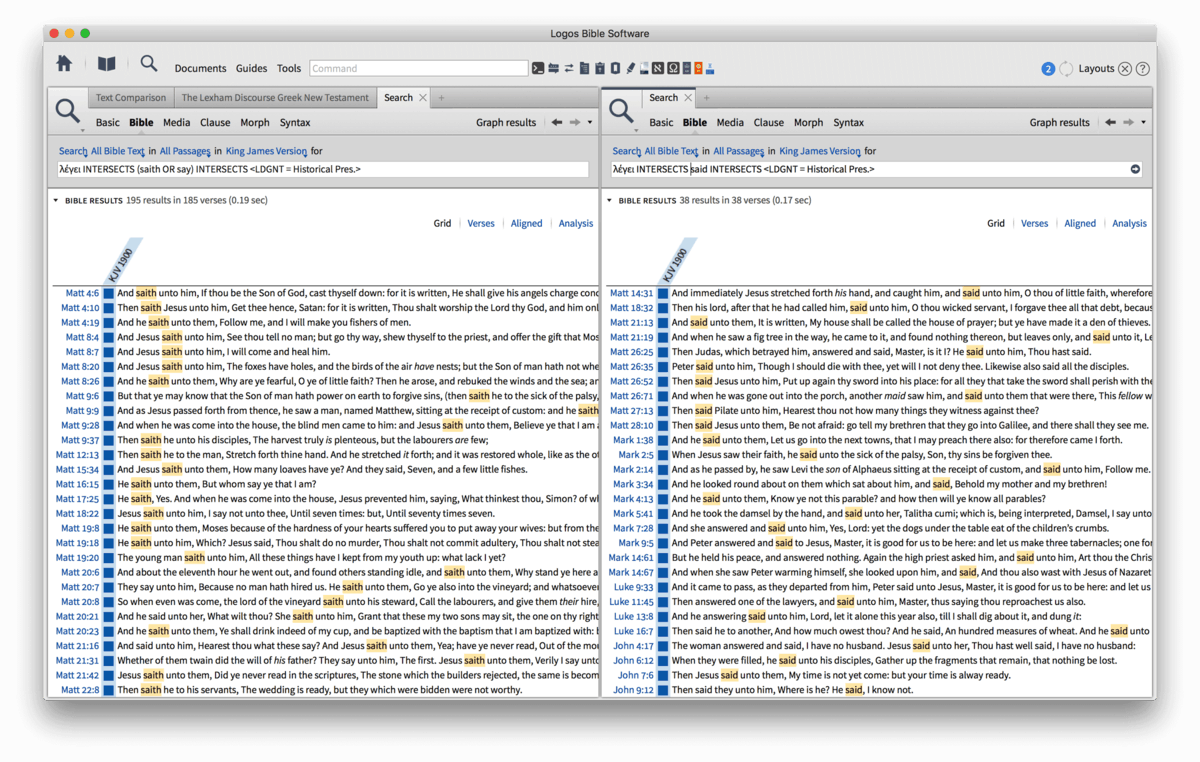Do you ever need to perform searches that connect English with Greek? For example, do you ever need to find out how a specific translation treats a given grammatical construction?
This is nearly impossible to do without the specialized tagging in Logos.
Let me show you a specific example from real life (if it weren’t for real life, I don’t think I’d have any interesting questions).
I am working with a team of volunteers on a specialized textual criticism project, the KJV Parallel Bible. It tries to make textual criticism accessible in a way it has never been before, by showing English readers, in English, the differences between the two major textual families of the Greek New Testament.
More importantly, it shows people in the pew the similarities between those families. Verse after verse is completely identical between the particular Majority and critical texts I’m using, and the textual variants that do show up are typically very minor—like the star that either “stood” over baby Jesus or “came to rest” over him. This is a difference without a distinction. Without such textual-critical facts, Christians are apt to be confused or even fearful: you mean there are different Bibles out there?
My team is trying to answer this question: if someone used a time machine to bring the NA28 to the KJV translators, what would the KJV NT look like?
One of my volunteers (and I happen to need more—any Bible nerds out there?), an MDiv student at New Orleans Baptist Theological Seminary, came across one of those real-life-generated interesting questions:
Look at this phrase in Mark 6:31:
TR: καὶ εἶπεν αὐτοῖς
NA28: καὶ λέγει αὐτοῖς
So here’s the question: if the KJV translators had had the NA28 in front of them, what would they have done with it? Would they have translated λέγει as a present tense verb or as a past tense verb?
Mark 6:31 in the NA28 provides a textbook example of a “historical present,” a past event related using present tense verbs. I had to figure out how often the translators of the King James Version rendered historical presents as pasts, and how often they rendered them as presents—so I could know how to translate λέγει as if I were a KJV translator. (Gotta love real life!)
The historical present
If you’re not familiar with historical presents, well—you are. You’ve heard them since you were small. They’re a common feature of English. Imagine a fourteen-year-old girl telling her friends what happened yesterday:
So I’m like, “You can’t possibly wear that!”
And she says, “But it’s my favorite!”
And I say, “Get a new favorite!”
The operative verbs structuring the narrative—“am,” “says,” and “say”—are all presents. But the conversation happened in the past. The historical present, in English at least, lends an air of excitement and breathless immediacy to a narrative about a completed event.
The New Testament has over 400 examples of the historical present, starting with “the angel of the Lord appears to Joseph in a dream” (Matt 2:13) and ending with “He who testifies these things says. . .” “Says” is in fact the most common verb placed in the historical present—just like the example above.
That air of breathless excitement is the reason grammarians give for the existence of the historical present in Koine Greek, too. And A.T. Robertson thinks that’s why Luke didn’t use it very often: he was the “scientific historian,” not the “dramatist” like John and Mark (867). The Gospels and Acts, because they are strongly narratival, contain the most instances of the historical present. The epistles have none. Revelation has a few, because it also includes narratives. Here’s a graph:
The historical present is a semantic category; that is, it’s not like case or gender, something that can be tagged more or less automatically by a computer based on a set of instructions. No, a human has to read the entire New Testament and mark all the present tense verbs that are part of narrations of past events.
So we hired some humans to do this. The tagging is in the Lexham Discourse Greek New Testament.
Real life
And that brings us back to my real-life question: how often did the KJV translators translate historical presents as past-tense verbs? In particular, how often did they render the word λέγει as “saith” (present) versus “said” (past)? Both the KJV and modern translations render some instances as past tense verbs, because that air of breathless excitement just feels too colloquial for the New Testament. (Even some ancient Greek writers avoided the construction because it was too much in the “vernacular,” Robertson says.) But both the KJV and modern translations (such as the ESV) also sometimes render them as presents.
So I ran two searches of the KJV in separate tabs in Logos:
1. λέγει INTERSECTS saith INTERSECTS <LDGNT = Historical Pres.>
2. λέγει INTERSECTS said INTERSECTS <LDGNT = Historical Pres.>
The first tells me not just how often λέγει is translated “saith,” but how often λέγει, when translated “saith” in the KJV, is also an instance of the historical present. I have to make this distinction because there are times when λέγει is used as a present, not a historical present (like “Hear what the Spirit says to the churches,” [Rev 2:7]).
The second tells me how often λέγει is translated as a past-tense verb when it’s a historical present.
And the winner is. . . translating the historical present with a present-tense verb!
So I says to the volunteer,
If the KJV translators took the historic present and, with perfect appropriateness in my mind, translated it as if it were an aorist [past tense] around 40 times, including 11 times in Mark, then we don’t have to make a distinction here. They very well might have translated this as “said” even if they had λέγει in front of them.
However… In the spirit of being “overmuch honest,” and because the KJV translators did prefer to translate historical presents as presents far more often than not, I say let’s make a distinction. I’d translate the NA28 reading as “and he saith unto them.”
The Bible Browser is a great, easy way to survey all historical presents. But only an “INTERSECTS” search combining Greek, KJV English, and the Lexham Discourse Grammar Greek New Testament could get me the answer I needed.
The value of human tagging
In exegesis and in Bible translation, discovering parallel examples is absolutely key. How did other exegetes or translators handle the construction you’re studying? Where else does it occur in the Greek New Testament? But searches for morphological form can only get you so far.
The great value of Logos for Bible study, both in original language and in English study, is that it can answer these questions because it can search for meaning, not merely for form.
Mark L. Ward, Jr. received his PhD from Bob Jones University in 2012; he now serves the church as a Logos Pro. He is the author of multiple high school Bible textbooks, including Biblical Worldview: Creation, Fall, Redemption.
Learn the Secrets of Mastering Logos
In our free 30-day course, we’ll walk you through essential skills that will maximize the power of Logos in your Bible study. Plus, you’ll learn a proven method for understanding the biblical writers’ original meaning—and how to bridge the gap from ancient context to everyday life. Put essential Bible study skills into practice as you work step-by-step through a guided study on the book of Jonah.
Learn more about this free 30-Day Bible Study Challenge or click the button below to get started.










